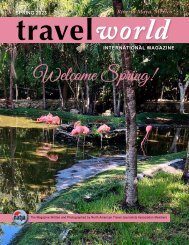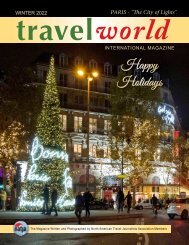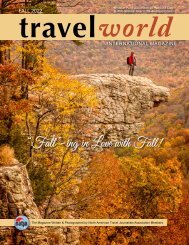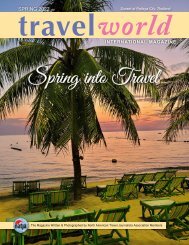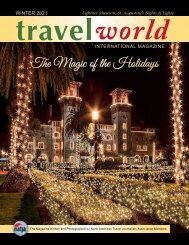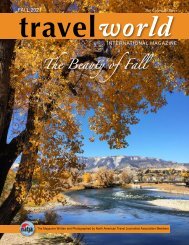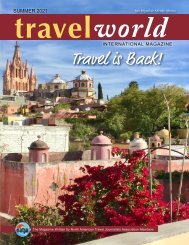TravelWorld International Magazine Summer 2024
The magazine written and photographed by North American Journalist Association members
The magazine written and photographed by North American Journalist Association members
Create successful ePaper yourself
Turn your PDF publications into a flip-book with our unique Google optimized e-Paper software.
Protecting the<br />
Caribbean<br />
Mural in the National Park in San Juan,<br />
Puerto Rico shows the walls and<br />
fortresses that protected the city<br />
S<br />
A<br />
N<br />
J<br />
U<br />
A<br />
N<br />
•<br />
P<br />
U<br />
E<br />
R<br />
T<br />
O<br />
R<br />
IC<br />
O<br />
Once the treasure fleets left Cartagena,<br />
they had to sail the treacherous waters<br />
of the Caribbean. To protect them, Spain<br />
built two incredible fortresses, El Morro<br />
– “the Bull” and Castillo San Cristobal,<br />
at the entrance to the Caribbean in San<br />
Juan, Puerto Rico. Now maintained by<br />
the National Park Service, their towering<br />
stone walls and museums present the<br />
most in-depth look at the lengths the<br />
Spanish had to go to fight these pirates.<br />
Did the defenses work? Well, our friend<br />
pirate Drake attacked San Juan in 1595 –<br />
and failed to capture the town.<br />
Today, the forts overlook the peninsula of<br />
Old San Juan that juts into the Caribbean<br />
like a thumb. Here, the sea is sparkling<br />
blue, beaches begin at the edge of the<br />
fortified stone walls, and the harbor,<br />
once filled with galleons, is now packed<br />
with a fleet of the world’s largest cruise<br />
ships. Nearly every house is covered with<br />
flowering trees, and (fittingly for a pirate<br />
town) you can tour the world’s largest rum<br />
distillery – Bacardi’s. Even the historic<br />
streets (Adoquines) are colorful. They<br />
are made of blue bricks that were cast<br />
from furnace slag and brought over on<br />
Spanish ships as ballast. Under the light of<br />
flickering lanterns, the streets glow with<br />
color as deep blue as the sea.<br />
National Park ranger in El Morro fortress<br />
El Morro, the Bull, is the Castillo<br />
San Felipe del Morro, and one of<br />
the best interpreted fortresses<br />
in English in the world since it is<br />
now a National Park.<br />
Walls surround the<br />
historic shore of<br />
Old San Juan,<br />
Puerto Rico<br />
Castillo de San Marcos was built of coquina, a local<br />
soft stone that absorbed cannonballs and was able to<br />
withstand a British siege.<br />
Catching the<br />
Trade Winds<br />
Next, the Spanish treasure fleets had to sail to the<br />
eastern shore of Florida to catch the favorable<br />
trade winds to Spain. It was here that they were<br />
most vulnerable to pirates, so in 1565, the oldest<br />
city in the United States, St. Augustine, FL, was<br />
built for one purpose: to fight pirates. The Spanish<br />
came to the hot, humid, bug-infested swamp<br />
that was Florida and laid out the first European<br />
grid-style town, a real city with streets and plazas.<br />
For protection, nine wood forts were built -- and<br />
destroyed by pirates in just the early years. Our<br />
friend, the infamous pirate Drake, burned the<br />
town in 1586, 34 years before the Pilgrims landed<br />
at Plymouth Rock.<br />
By 1672, Spain had enough and construction<br />
started on the Castillo de San Marcos – the oldest<br />
and best-preserved stone fort in the United States.<br />
Today, the huge diamond-shaped fortress is a<br />
National Monument. You can walk the ramparts<br />
along the top of its towering, 28-foot-tall walls,<br />
defend the drawbridge, climb out on the bastions<br />
for a view of the harbor, and watch cannons being<br />
fired by re-enactors in Spanish uniforms.<br />
It's just a musket shot from the fort to the St.<br />
Augustine Pirate & Treasure Museum. This is<br />
the largest and most authentic collection of pirate<br />
artifacts ever displayed under one roof. Of course,<br />
there are not many pirate artifacts! Most of the<br />
pirates were hanged or killed (Blackbeard went<br />
down with five bullet holes and 20 sword cuts, and<br />
they sliced off his head for good measure).<br />
Entrance to the Castillo de San Marcos.<br />
Pirate Treasure Museum<br />
St. Augustine captures feel of<br />
a pirate town.<br />
St. Augustine, Florida has been<br />
burned by pirates and the British,<br />
but is now a beautiful colonial<br />
town of plazas and fountains.<br />
St. George Street looks like a<br />
setting for pirate movies.<br />
So, there are not a lot of genuine artifacts, but you can see<br />
Blackbeard’s blunderbuss, one of the three remaining “Jolly<br />
Roger” pirate flags, and Captain Thomas Tew’s original<br />
treasure chest – the only known authentic pirate chest in<br />
existence.<br />
The museum is just one of St. Augustine’s pirate attractions.<br />
On their quaint pedestrian streets lined with taverns and<br />
shops, you can’t throw a cutlass without hitting some mention<br />
of pirates. Or even a real pirate. A half dozen people in pirate<br />
costumes continually walk the streets posing for pictures.<br />
S<br />
T<br />
A<br />
U<br />
G<br />
U<br />
S<br />
T<br />
I<br />
N<br />
E<br />
•<br />
F<br />
L<br />
O<br />
R<br />
ID<br />
A<br />
28<br />
29







